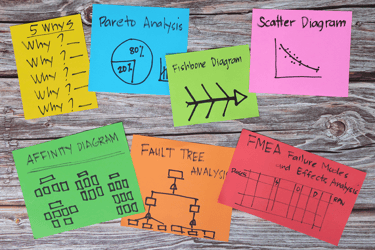The Packaging Industry's Sustainability Challenge: Why ERP Systems Are Essential for Success A straightforward guide to navigating sustainability regulations across folding carton, flexible...
What is Packaging Automation & Why Do You Need It? A Guide to Automation System Integration
According to Future Market Insights, the global packaging automation market was valued at $74.53 billion last year and is predicted to grow around 8% each year to reach $161.66 billion by 2033.
In the fast-paced world of manufacturing and distribution, efficiency is vital. Packaging automation stands out as a crucial strategy companies employ to streamline operations, especially in the context of Industry 5.0 and lean manufacturing.
But what exactly is packaging automation, and why should your business consider implementing it? Let’s examine the basics and explore the compelling reasons for embracing this technology.
TL;DR: Packaging automation uses advanced machinery and technology to streamline processes, reducing manual labor and errors. This results in faster production, better accuracy, improved safety, and lower costs, making it essential for companies to enhance efficiency and stay competitive.
Contents
- What is packaging automation?
- 5 key components of packaging automation
- Why do you need packaging automation?
- Getting started with packaging automation
- Conclusion
What is packaging automation?
Packaging automation uses technology and machinery to handle, process, and package products with minimal human intervention. This can include a range of processes, from filling and sealing to labeling and palletizing. Automation systems can vary from simple, semi-automated setups to complex, fully integrated systems capable of managing high volumes and diverse product lines.
5 key components of packaging automation
1. Filling machines: Automated fillers ensure that products, whether liquid, powder, or granular, are accurately dispensed into containers.
2. Sealing machines: These machines close containers securely, whether it’s through heat sealing, pressure sealing, or other methods.
3. Labeling machines: Automated labelers apply labels to products or packaging precisely and quickly.
4. Wrapping machines: These machines wrap products or pallets with film or other materials to ensure protection during transit.
5. Palletizing systems: Automated palletizers stack and organize products on pallets for efficient storage and shipping.
Enterprise Resource Planning (ERP) systems play a pivotal role in packaging automation by integrating and streamlining these components. Packaging-specific ERP systems, like ePS Radius ERP, can manage and automate inventory levels, production schedules, and order processing, ensuring that packaging operations are aligned with overall business objectives. By providing real-time data and analytics, ERP systems help optimize machine performance, reduce downtime, and enhance decision-making, ultimately leading to more efficient and cohesive packaging processes.
Why do you need packaging automation?
Increased efficiency and speed
- Speed: Automated systems operate at a faster pace than manual processes. They can handle large volumes of products quickly, reducing bottlenecks and increasing throughput. In fact, according to Zipdo, automation in manufacturing can lead to a productivity increase of up to 30%
- Consistency: Automation ensures that each package is filled, sealed, and labeled uniformly. This consistency improves product quality and reduces errors.
- Traceability and compliance: Ensuring that packaging is produced safely and that there is a clear chain of custody is becoming more relevant every day. Any automation project must be able to automatically build in traceability.
Cost savings
- Operational costs: Automation can significantly lower operational costs. The same Zipdo report mentioned previously summarized that automation can reduce manufacturing operational costs by up to 25%. Although the initial investment may be high, the long-term savings often outweigh the upfront expenses.
- Material savings: Automated systems are designed to minimize waste. For example, precise filling machines reduce the amount of product spillage and packaging material waste.
Improved accuracy and quality control
- Precision: Automation systems are programmed to follow exact specifications, leading to fewer mistakes in filling, labeling, and sealing.
- Quality assurance: With automated inspection systems, companies can detect and correct defects or inconsistencies in real time, maintaining high-quality standards.
Enhanced safety
- Reduced human error: Automation minimizes the risk of human error and injury by handling repetitive and potentially hazardous tasks.
- Ergonomics: Automation reduces the physical strain on workers by taking over heavy lifting and repetitive motions, leading to a safer and healthier work environment.
- Monitoring: In-line, real-time monitoring is critical to having a full audit and traceable production, so if a recall occurs or compliance reports are needed, they can be produced with no additional effort.
Scalability and flexibility
- Adaptability: Modern automated systems can be reconfigured to handle different products or packaging types, making it easier to adapt to market changes or new product lines.
- Scalability: As your business grows, automated systems can often be expanded or upgraded to meet increased demand, ensuring you can scale operations efficiently.
Enhanced data collection and analysis
- Real-time monitoring: Automation systems often have advanced sensors and data collection tools that provide real-time insights into production processes.
- Data utilization: By analyzing this data, companies can identify trends, optimize processes, and make informed decisions to improve efficiency further.
Getting started with packaging automation
If you’re evaluating a packaging technology solutions for your business, here are a few steps to guide you:
- Assess your needs: Evaluate your current packaging processes to identify bottlenecks, inefficiencies, or areas where automation could benefit most.
- Research solutions: Explore different types of automation technologies and vendors. Look for solutions that align with your specific requirements and budget.
- Consult with experts: Work with packaging automation specialists who can provide insights and recommendations based on your needs.
- Plan for integration: Ensure the new automation systems seamlessly integrate with your existing production lines and processes.
- Train your team: Proper training is crucial for ensuring that your team can operate and maintain the new automated systems effectively.
Conclusion
Packaging automation is more than just a trend - it’s a crucial component of modern manufacturing and distribution that offers significant advantages in terms of efficiency, cost savings, quality, and safety.
By embracing automation, businesses can not only streamline their operations but also position themselves for long-term success in an increasingly competitive market. If you still rely on manual packaging processes, it might be time to consider how automation can revolutionize your operations and take your business to the next level.
Is your Enterprise resource planning (ERP) lacking industry-specific functionality?
Explore how MES Applications can unify your data, accelerate quoting, and optimize your manufacturing processes - whilst saving time and money.
Our team of experts is here to help you; from initial assessment to implementation or if you want to make a start on doing your own gap analysis, download the template below.





